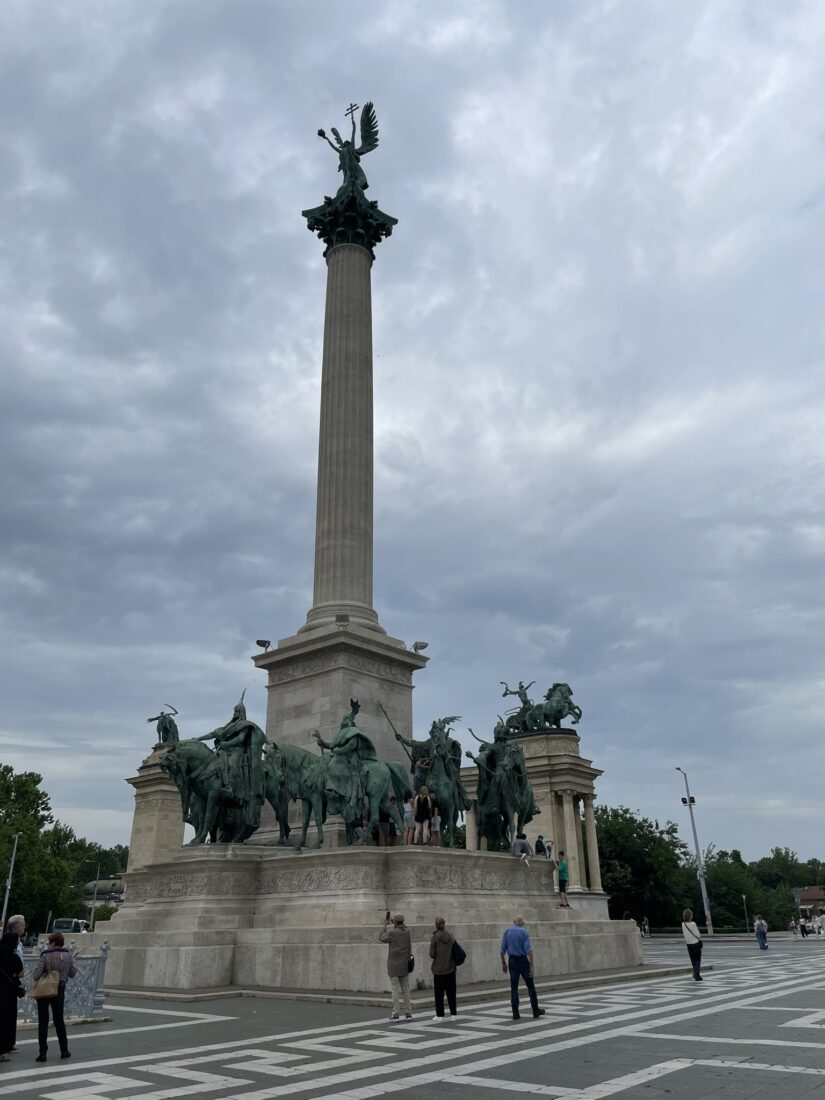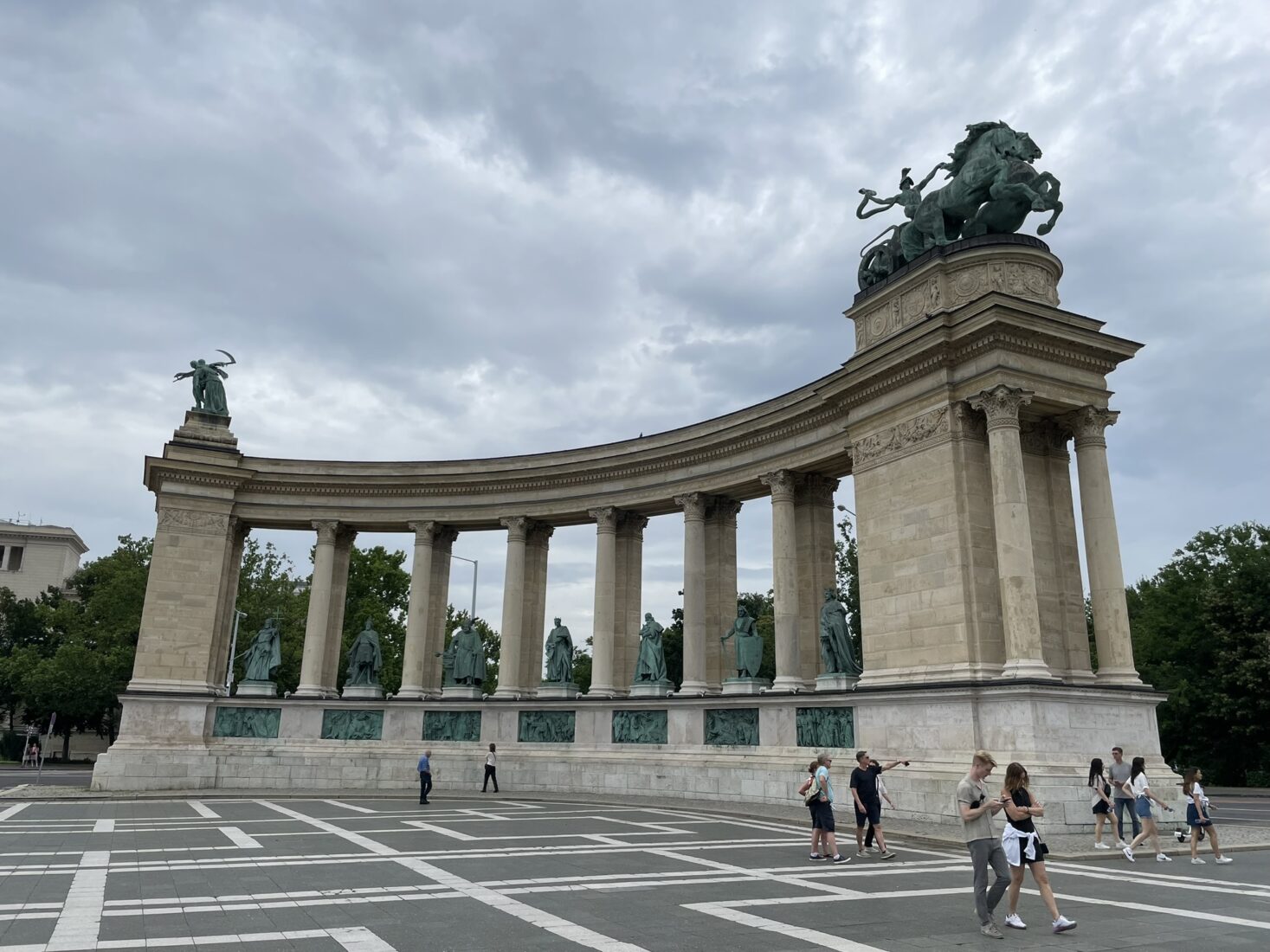
The Millennium Monument, one of the symbols of Budapest, is a magnificent monument built in Heroes' Square for the celebration of Hungary's one thousandth anniversary. The monument stands out as a symbol of Hungarian history and cultural heritage.

Planned in 1896 as part of the millennium celebrations, the monument was not actually completed until 1906. Most of the original sculptures designed by Albert Schickedanz were reconstructed by Gyorgy Zala and completed in 1926.
In the center, on a 36-meter-high column, is a statue of the archangel Gabriel ("the man of God", "the power of God" or "God proved to be powerful"), about 5 meters tall, holding the Hungarian crown in one hand and the double cross of the apostles in the other, as legend has it that the founder of the state, St. Stephen, did in a dream.
On the left and right columns are bronze statues of 7-7 prominent figures of Hungarian history, while the open stone bases of the statues are decorated with reliefs depicting historical scenes from the time or activities of the figures.
On the pedestal of the central column are the seven conquering chiefs, on the left (from back to front) Tohotom, Ond, Kond, on the right (from back to front) Tas, Huba, Elod and the Hungarian prince Arpad.
The metal plate between the memorial stone of the heroes and the statue of General Arpad hides an artesian well with thermal water. Vilmos Zsigmondy started digging the well in 1868 and on June 4, 1877 he found thermal water at a depth of 970 meters.

The monument is decorated with four allegorical bronze statues:
These statues are set on open stone pedestals decorated with details describing Hungary's historical and cultural development.
Inaugurated in 1929, the Heroes Memorial Stone is dedicated to the memory of those who lost their lives in the First World War. This stone emphasizes the courage and sacrifice of Hungarian national heroes.

The monument and its stone underwent a complete restoration in 2000-2001 and was declared a national monument by the Hungarian Parliament. The inscription added to the structure during this restoration reflects the determination to keep the memory of Hungarian heroes alive.

The statue of Hunyadi Janos on the right wing of the Millennium Monument represents Janos Hunyadi, a medieval commander who played an important role in Hungary's struggle against the Turks.
Hunyadi Yanos, (1407 - August 11, 1456), medieval Hungarian army commander. The Hunyadis, a family from the region of Erdel (Transylvania), most probably of Romanian origin, received the feudal rights to the castle of Hunyad from Sigismund, Holy Roman Germanic Emperor and King of Hungary, in 1409.
Janos Hunyadi entered the military service of King Sigismund in his youth. He distinguished himself in the wars against the Bulgarians, then against the Ottomans. He was appointed voivodeship of Erdel in 1441 by King Ulaszlo I of Hungary (King Wladyslaw III of Poland). Hunyadi defeated the Ottoman army around Belgrade several times during the last days of the Ottoman Sultan Murad II.
Murad II, who succeeded Sultan Mehmed II and retired to Manisa, signed the Segedin peace with the Hungarians in 1444. Although the two monarchs swore an oath with their holy books, the peace was broken with the encouragement of the Pope.
The Crusader army, including Hunyadi, besieged Varna. At the Battle of Varna, the Crusaders suffered a terrible defeat. Hunyadi became the ruler of Hungary in the capacity of regent because Laszlo V, who was elected in place of King Ulaszlon I, who died in the war, was a child, and he continued this duty between 1446 and 1453.
In 1447, he killed Vlad II, the Wallachian Voivode who wanted to offer allegiance to Murad II.

Janos Hunyadi's role in the defeat of the Ottoman forces during the 1456 siege of Belgrade led to his adoption as a Hungarian national hero in later centuries. Hunyadi died of the plague that spread through his army during the 1456 siege. One of his sons, Matyas, reigned as king of Hungary under the name Matyas I (1458- 1490).

Hunyadi is especially known for his successes at the Siege of Belgrade and is considered a Hungarian national hero.
In conclusion, Heroes' Square and the Millennium Monument in the heart of Budapest is an important monument that attracts the attention of both locals and visitors with its historical depth and symbolism.
As an important monument to Hungary's past and cultural identity, it is of great value both in terms of aesthetics and meaning.